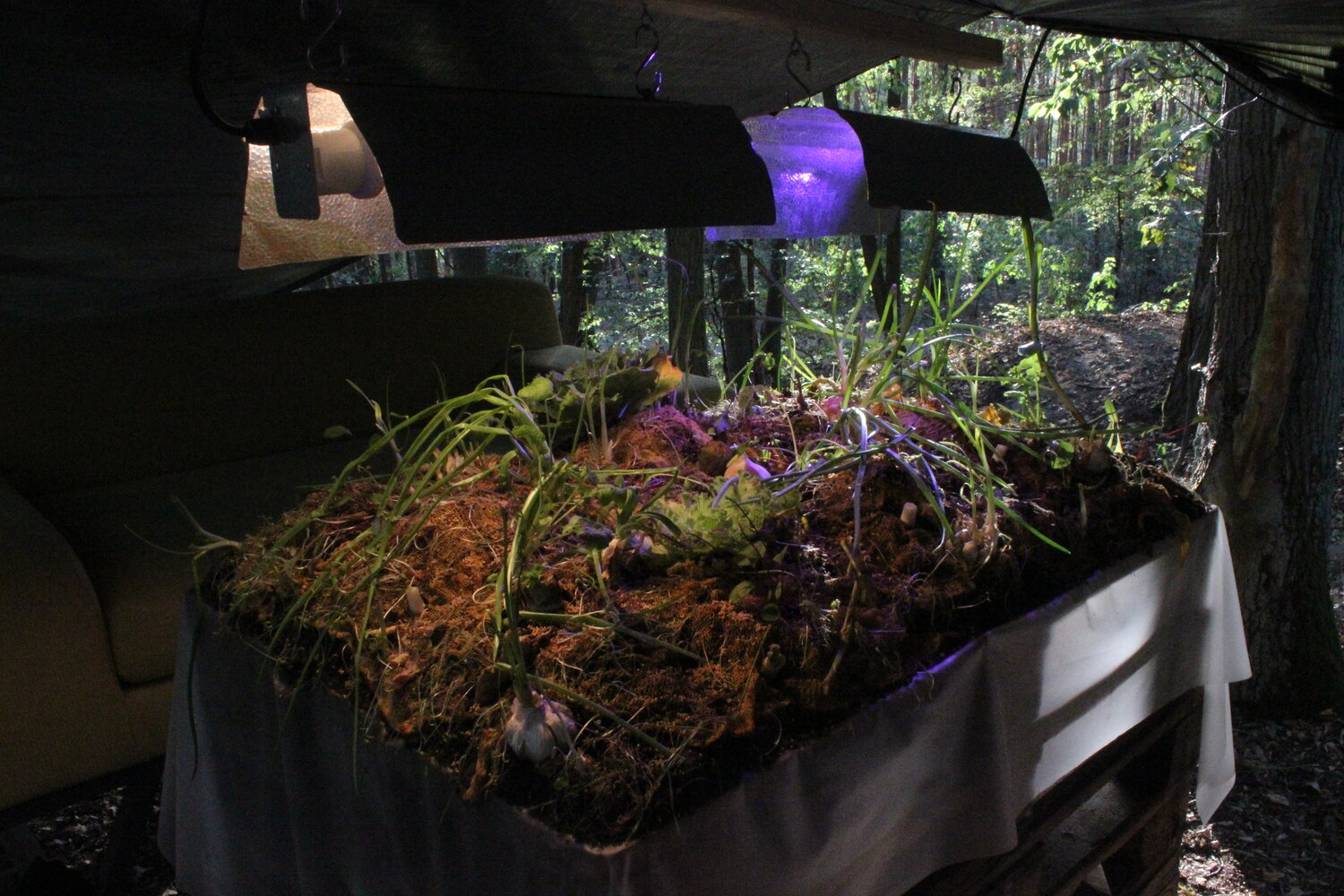In this space, roofed with tarp, but with open sides to sense and still be in the forest, is a scene which imitates something like a mealtime. There are two sofas which you can sit on and a table of what was or might become a meal. There should be an eery echoing of noises, blanketing the space which you might normally fill with conversation. Overhead, pink and yellow lights should illuminate and nurture what has been creeping up beneath them. But this depends on the supply of electricity, that in a forest cannot always be had. Regardless, the edibles will continue to grow in only the murky forest light, be it even with a slight yellow unhealthy tinge.
Around the feet of the sofas are screens, some on, some off. It is unclear whether they show something of the past, present or future, or perhaps a future sense of past, or nostalgic sense of the future. The footage, taken in Niigata, Japan, and in London and South East England, points towards food, agriculture, and a speculative disassociation and consideration of what food is, where it comes from, and what we should do with it.
This digesting stems from observing vegetables when they are left past their best, or the parts not normally eaten are nurtured back to life. A nod to the cycle of life, of vegetables. The commercialisation of food, and the mass-production of processed and fresh foods has, particularly in parts of the world that rely heavily on supermarkets, led to fresh foods being seen as end-products, with little regard for the before or after, of their consumption. Vegetarianism and veganism have indeed drawn attention to the lives of animals that are reared for human use and consumption. However, this work focuses on a contemporary human relationship to the plant matter that we consume.
If you are asking why the sofas are so tall, perhaps you have never seen a tall sofa. They are grown sofas, but sitting on them might make you feel small. After you climb up, your feet might dangle like they might have when you were a child. They might not. You might sit there with a friend and talk, or you might sit on your own and listen and watch, you might see something growing. Think relax, think after-work drinks, so think slightly alert, and not slumped. An in-between space, where you could eat, drink, work, rest or socialise, although here the plants seem to be the centre of attention.
The piece demands your time, to walk up the path, to climb up, to sit down, to watch and to listen. But that sense of time taken or spent is an attempt too, to make you pause for a moment and piece together the familiar and unfamiliar clues and props around you. You are inside something that although might not seem too challenging to navigate, may also seem foreign to you. In fact, you might feel some affinity with the vegetables in the centre, as they resemble something you ate yesterday. Yet, a lot of the vegetables you see might in some sense begin to seem foreign, not in the sense that they lend themselves to another culture, but that they have grown out of our time, or the time that we would normally care for them. If you find yourself comfortable on the sofa, perhaps the fecund scene in front of you might be alive enough to unsettle something.
2 sofas on steel legs, rubber adjustable feet, spraypaint.
Table - pallets, PVC tablecloth, earth, vegetables, plants, seeds, cotton knitting knitted on domestic knitting machine.
Reflective grow lights, tungsten and hydroponic bulbs, household lights. Films shown on TV screens, audio and speakers.
House plants, tarpaulin, rope.
Table - pallets, PVC tablecloth, earth, vegetables, plants, seeds, cotton knitting knitted on domestic knitting machine.
Reflective grow lights, tungsten and hydroponic bulbs, household lights. Films shown on TV screens, audio and speakers.
House plants, tarpaulin, rope.







